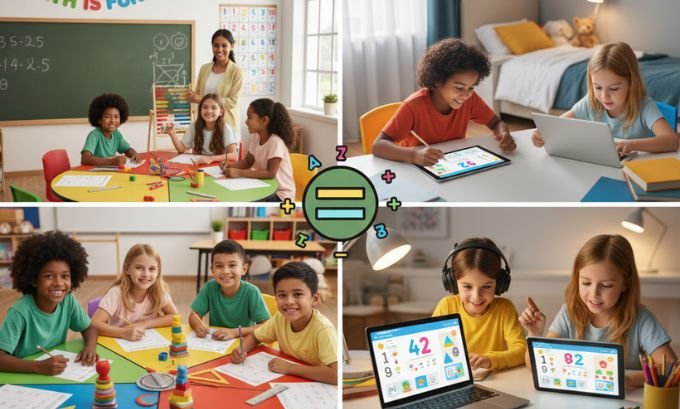In a world where classrooms extend beyond physical walls, finding the right distance learning resources is crucial for educators and parents alike. The best resources are those that are not only engaging but also built on a solid foundation of educational technology standards. These tools should be easy to integrate, effective for students, and backed by a structure that supports long-term learning goals.
This guide explores the top platforms and the underlying technologies that make them work. We will delve into specific tools like K5 Math Resources and Brainingcamp, and also unpack the technical frameworks like SCORM and XML that power modern digital education. By understanding both the “what” and the “how,” you can make informed decisions to create a powerful and effective learning environment.
Table of Contents
The Best Distance Learning Resources for K-5 Math
For elementary school teachers and parents, finding high-quality math resources is a top priority. The ideal tools make abstract concepts tangible and learning fun. They should offer a mix of practice, exploration, and assessment to cater to different learning styles.
Fortunately, several platforms excel in this area. From free, printable worksheets to interactive virtual manipulatives, the options are vast. Resources like K5 Math Resources provide excellent foundational materials, while platforms like Brainingcamp bring hands-on learning into the digital space. Let’s explore some of the most effective options available for K-5 math education.
My Experience with Digital Math Tools
As an educator who transitioned to a hybrid teaching model, I spent countless hours testing various distance learning resources. My goal was to find tools that could bridge the gap between in-person and remote instruction without overwhelming my students or their parents. For my fourth-grade class, I needed resources that were aligned with curriculum standards but also flexible enough for students to use independently at home.
I started with K5 Math Resources, which was a lifesaver for creating homework packets and in-class centers. The site offers a wealth of free, downloadable worksheets sorted by grade and topic. I could easily find materials on fractions, geometry, and number sense that matched our lesson plans. I would often take a screenshot of a specific activity and post it to our Google Classroom for a quick warm-up exercise.
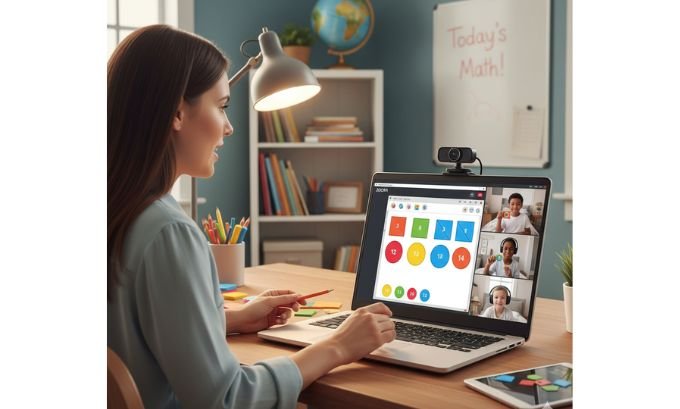
While worksheets were great for practice, I noticed my students missed the hands-on aspect of our classroom math centers. That’s when I discovered Brainingcamp. This platform offers virtual manipulatives, from base-ten blocks to fraction circles. During a live Zoom lesson on decimals, I shared my screen and used the virtual decimal grid. Students could watch me model the concept, and then they could use the same tool on their own devices. The immediate visual feedback was incredibly powerful. One student, who had struggled with place value, finally had his “aha!” moment when he could physically drag and drop the blocks to see the relationship between tenths and hundredths.
What I Like / Strengths
- Accessibility and Cost: Many high-quality resources, like K5 Math Resources, are completely free. This removes financial barriers for schools, teachers, and parents.
- Engagement: Tools like DataMap and Mathletics Box use gamification, interactive stories, and puzzles to make learning feel less like a chore.
- Visual Learning: Brainingcamp provides virtual manipulatives that help students visualize and interact with abstract math concepts, which is critical for deep understanding.
- Curriculum Alignment: Many resources are designed to align with national or state standards, making it easier for teachers to integrate them into their lesson plans. Ohio SchoolNet, for example, provides templates that help teachers ensure their activities meet specific learning objectives.
Areas for Improvement
- Subscription Costs: While many tools offer free trials, premium platforms like DataMap and Mathletics Box require a paid subscription, which can be a barrier for some families or underfunded schools.
- Technical Requirements: Some interactive platforms require a stable internet connection and a modern device, which may not be available to all students.
- Overwhelming Options: The sheer number of available resources can be overwhelming. Without a clear understanding of what to look for, educators can spend too much time searching and not enough time teaching.
- Teacher Training: To be used effectively, many digital tools require some level of training. Platforms that lack strong tutorials or support can be underutilized.
Understanding the Technology Behind the Tools
The most effective distance learning resources are more than just flashy websites. They are built on a sophisticated technical framework that ensures they can work together seamlessly. This concept is known as interoperability, and it’s the key to creating a flexible and scalable digital learning ecosystem.
At the heart of this ecosystem are Learning Objects—small, reusable chunks of digital content designed to teach a single concept. Think of a video explaining photosynthesis, an interactive quiz on the periodic table, or a simulation of a physics experiment. Each one is a self-contained learning unit.
Frameworks like SCORM (Sharable Content Object Reference Model) provide the rules for how these Learning Objects are created and packaged. By following these standards, developers can ensure their content will work with any learning management system (LMS) that is also SCORM-compliant. The IMS Global Learning Consortium is a key organization that drives these standards, working to create a unified digital learning landscape.
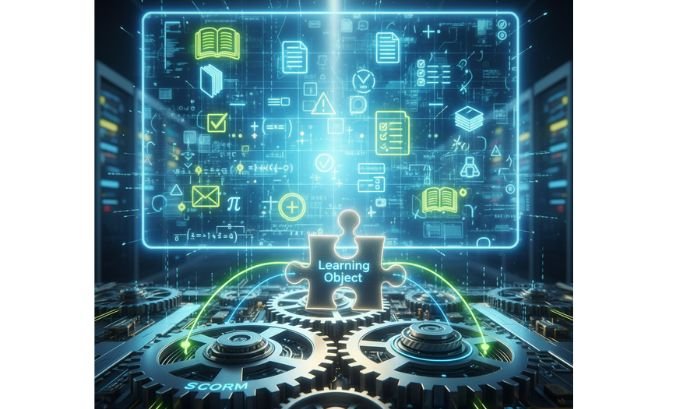
How Standards like SCORM and XML Work in Practice
To truly appreciate the power of these standards, let’s look at a real-world scenario. Imagine a school district wants to create a customized online science curriculum for its middle school students. The curriculum director, Sarah, doesn’t want to be locked into a single content provider. She wants to pull the best resources from various sources.
This is where Learning Objects and SCORM become game-changers. Sarah’s district uses a SCORM-compliant LMS. She finds a fantastic interactive simulation about the solar system from a NASA-affiliated developer. Because it’s a SCORM package, she can upload it directly into her district’s LMS. The package contains the simulation itself, plus metadata that tells the LMS what the object is, what learning objective it meets, and how to track student progress.
Next, she purchases a set of video lessons on cell biology from a different publisher. These are also packaged as SCORM-compliant Learning Objects. She adds them to her curriculum. Finally, she uses a quiz-authoring tool to create her own assessments. The tool exports the quizzes as SCORM packages.
Behind the scenes, XML (Extensible Markup Language) is doing the heavy lifting. XML is a markup language that structures the data within the SCORM package. It uses tags to define the content, much like HTML does for web pages, but it’s far more flexible. An XML file might contain tags like <title>, <learningObjective>, and <masteryScore>. This structured data allows the LMS to understand and manage the content.
Because all these resources adhere to the same standards, Sarah can mix and match them to build a unique, high-quality curriculum. When a student completes the solar system simulation, the Learning Object sends data back to the LMS, recording the student’s score and completion status. The LMS can then unlock the next lesson automatically. This level of automation and flexibility would be impossible without standards like SCORM and the data structure provided by XML.
The researcher Stephen Downes, a prominent voice in educational technology, has written extensively about the power of Learning Objects. He argues that by breaking down courses into smaller, shareable components, we can create more affordable, accessible, and higher-quality education for everyone. His vision is one where educators are not just content creators but also expert curators, assembling the best possible learning experiences from a global repository of resources.
Comparing Top Distance Learning Resources
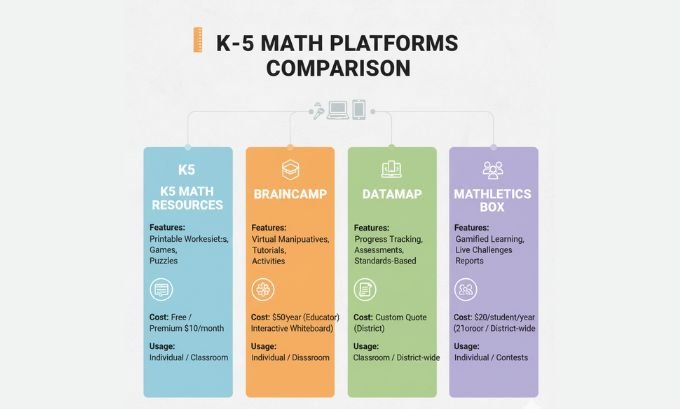
With so many options available, it can be helpful to see a side-by-side comparison. The table below breaks down four popular math resources based on their primary function, cost, and ideal use case.
| Resource | Primary Function | Cost Model | Best Use Case |
|---|---|---|---|
| K5 Math Resources | Printable worksheets, lessons, and activities | Free | Supplementing classroom instruction, homework, and math centers. |
| Brainingcamp | Virtual math manipulatives and interactive tools | Subscription-based (with free trial) | Live online teaching, demonstrating abstract concepts, and independent student exploration. |
| DataMap (Scholastic) | Interactive math magazines with articles and games | Subscription-based (with free samples) | Integrating literacy and math, cross-curricular projects, and engaging reluctant learners. |
| Mathletics Box | Physical subscription box with hands-on activities | Subscription-based | Blended learning environments, family math nights, and providing tangible learning materials. |
This comparison highlights that the “best” resource often depends on your specific needs. A teacher looking for free, reliable practice materials might lean on K5 Math Resources. An educator focused on interactive, conceptual teaching during live lessons would find Brainingcamp invaluable. For a cross-curricular approach, DataMap excels, while Mathletics Box is perfect for those who want to combine digital and physical learning.
Putting It All Together: A Lesson Plan Example
To see how these resources and concepts work in harmony, let’s design a sample lesson plan for a fifth-grade math class learning about volume. The lesson plan will follow a structure similar to one you might find on Ohio SchoolNet, which emphasizes clear objectives and varied activities.
Topic: Introduction to Volume
Grade Level: 5th
Learning Objective: Students will be able to define volume and calculate the volume of rectangular prisms using the formula V = l × w × h.
Lesson Activities:
- Introduction (10 minutes):
- Hook: Start with an engaging video from a Learning Object repository about how architects use volume to design buildings.
- Discussion: Ask students what they think “volume” means.
- Direct Instruction & Exploration (20 minutes):
- Tool: Use Brainingcamp‘s virtual cubic blocks.
- Activity: Share the screen and demonstrate how to build a rectangular prism with specific dimensions (e.g., 3x2x4). Have students count the blocks to find the volume.
- Guided Practice: Give students the dimensions for a new prism and have them build it on their own devices using Brainingcamp.
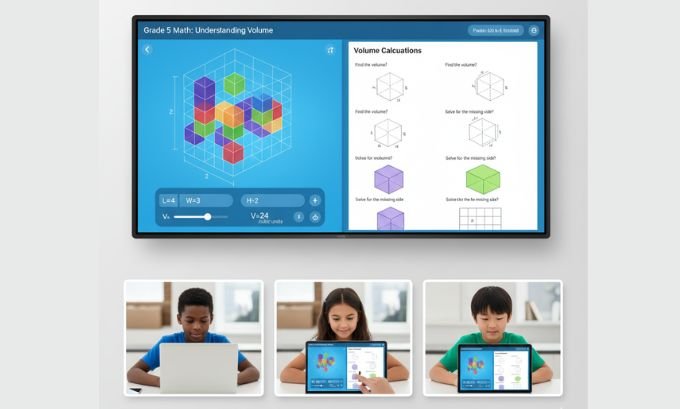
- Independent Practice (15 minutes):
- Resource: Assign a worksheet from K5 Math Resources on calculating volume.
- Instructions: Students complete the worksheet independently. The problems should start with visual representations and gradually move to formula-based calculations.
- Application & Enrichment (15 minutes):
- Resource: An article from DataMap magazine titled “The Secrets of Shipping Containers.”
- Activity: Students read the article, which discusses how companies use volume to maximize shipping efficiency. They then solve a word problem related to the article. This integrates literacy and real-world application.
- Assessment (5 minutes):
- Tool: A short, 3-question quiz created with a SCORM-compliant authoring tool.
- Delivery: The quiz is delivered through the school’s LMS. The results are automatically recorded.
This lesson plan uses a variety of distance learning resources to address different learning styles. It moves from concrete visualization (Brainingcamp) to abstract practice (K5 Math Resources) and real-world application (DataMap). The entire experience is managed through an LMS, with assessments and progress tracked using SCORM standards. This is the future of effective, integrated digital education.
Frequently Asked Questions (FAQ)
1. What are the most important features to look for in distance learning resources?
Look for resources that are engaging, easy to use, and aligned with curriculum standards. For digital tools, ensure they are compatible with your school’s devices and learning management system. Interoperability, often achieved through standards like SCORM, is a key feature for seamless integration.
2. How can I find free distance learning resources?
Many excellent resources are available for free. Websites like K5 Math Resources, Khan Academy, and PBS LearningMedia offer a vast library of videos, lesson plans, and interactive activities at no cost. Your local library may also provide free access to digital learning platforms.
3. What is a “Learning Object”?
A Learning Object is a reusable, self-contained piece of digital content designed to teach a single, specific objective. It could be a video, a quiz, a simulation, or a short article. The concept, popularized by thinkers like Stephen Downes, allows educators to build custom courses by mixing and matching these objects.
4. Why is SCORM important for online courses?
SCORM (Sharable Content Object Reference Model) is a set of technical standards that ensures learning content can work with any compliant learning management system (LMS). This allows schools and teachers to use resources from different developers without worrying about compatibility issues.
5. How can I ensure my child stays focused during distance learning?
To improve focus, create a dedicated, quiet learning space. Stick to a consistent schedule that includes regular breaks. Use a variety of engaging resources, such as interactive games from DataMap or hands-on virtual tools from Brainingcamp, to maintain interest.
6. What is the role of the IMS Global Learning Consortium?
The IMS Global Learning Consortium is a non-profit organization that develops open standards for educational technology. Their work on specifications for content packaging, assessment, and interoperability helps create a more connected and efficient digital learning ecosystem for everyone.
7. How does XML relate to distance learning?
XML (Extensible Markup Language) is a foundational technology used to structure and transport data. In distance learning, it is often used within SCORM packages to describe the content of a Learning Object, allowing a learning management system to understand and manage it correctly.
Conclusion
Navigating the world of distance learning resources requires more than just picking the most popular tools. It demands an understanding of what makes them effective, both pedagogically and technically. By combining engaging, curriculum-aligned platforms like K5 Math Resources, Brainingcamp, and DataMap with a solid foundation of technical standards like SCORM and XML, educators can build powerful, flexible, and truly personalized learning experiences.
The principles promoted by the IMS Global Learning Consortium and envisioned by experts like Stephen Downes are no longer theoretical—they are being put into practice in classrooms every day. As you continue to explore and implement these resources, remember that the ultimate goal is to create a dynamic learning environment that empowers every student to succeed, no matter where they are.
Ready to build your own integrated digital curriculum? Start by exploring one of the resources mentioned in this guide and see how it can fit into your existing lesson plans.

